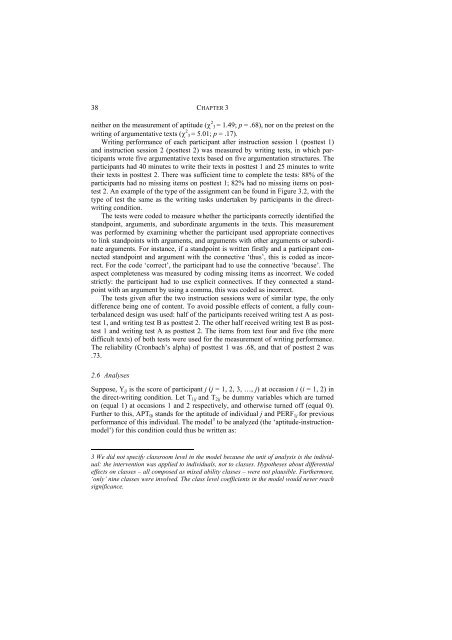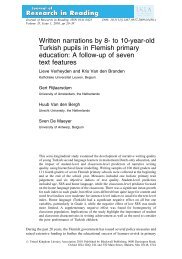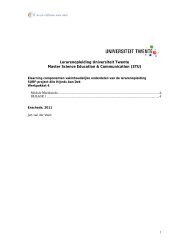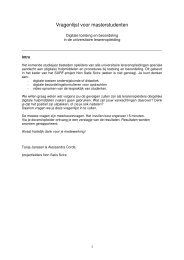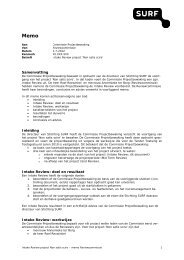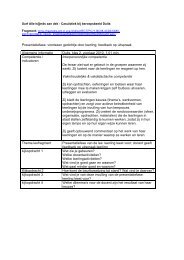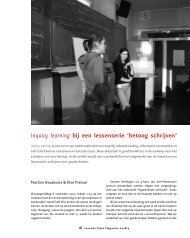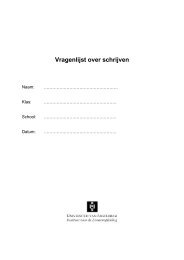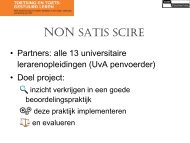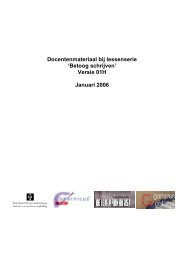OBSERVATIONAL LEARNING IN ARGUMENTATIVE WRITING
OBSERVATIONAL LEARNING IN ARGUMENTATIVE WRITING
OBSERVATIONAL LEARNING IN ARGUMENTATIVE WRITING
You also want an ePaper? Increase the reach of your titles
YUMPU automatically turns print PDFs into web optimized ePapers that Google loves.
38 CHAPTER 3<br />
neither on the measurement of aptitude (χ 2 3 = 1.49; p = .68), nor on the pretest on the<br />
writing of argumentative texts (χ 2 3 = 5.01; p = .17).<br />
Writing performance of each participant after instruction session 1 (posttest 1)<br />
and instruction session 2 (posttest 2) was measured by writing tests, in which participants<br />
wrote five argumentative texts based on five argumentation structures. The<br />
participants had 40 minutes to write their texts in posttest 1 and 25 minutes to write<br />
their texts in posttest 2. There was sufficient time to complete the tests: 88% of the<br />
participants had no missing items on posttest 1; 82% had no missing items on posttest<br />
2. An example of the type of the assignment can be found in Figure 3.2, with the<br />
type of test the same as the writing tasks undertaken by participants in the directwriting<br />
condition.<br />
The tests were coded to measure whether the participants correctly identified the<br />
standpoint, arguments, and subordinate arguments in the texts. This measurement<br />
was performed by examining whether the participant used appropriate connectives<br />
to link standpoints with arguments, and arguments with other arguments or subordinate<br />
arguments. For instance, if a standpoint is written firstly and a participant connected<br />
standpoint and argument with the connective ‘thus’, this is coded as incorrect.<br />
For the code ‘correct’, the participant had to use the connective ‘because’. The<br />
aspect completeness was measured by coding missing items as incorrect. We coded<br />
strictly: the participant had to use explicit connectives. If they connected a standpoint<br />
with an argument by using a comma, this was coded as incorrect.<br />
The tests given after the two instruction sessions were of similar type, the only<br />
difference being one of content. To avoid possible effects of content, a fully counterbalanced<br />
design was used: half of the participants received writing test A as posttest<br />
1, and writing test B as posttest 2. The other half received writing test B as posttest<br />
1 and writing test A as posttest 2. The items from text four and five (the more<br />
difficult texts) of both tests were used for the measurement of writing performance.<br />
The reliability (Cronbach’s alpha) of posttest 1 was .68, and that of posttest 2 was<br />
.73.<br />
2.6 Analyses<br />
Suppose, Yij is the score of participant j (j = 1, 2, 3, …, j) at occasion i (i = 1, 2) in<br />
the direct-writing condition. Let T1ij and T2ij be dummy variables which are turned<br />
on (equal 1) at occasions 1 and 2 respectively, and otherwise turned off (equal 0).<br />
Further to this, APT0j stands for the aptitude of individual j and PERF1j for previous<br />
performance of this individual. The model 3 to be analyzed (the ‘aptitude-instructionmodel’)<br />
for this condition could thus be written as:<br />
3 We did not specify classroom level in the model because the unit of analysis is the individual:<br />
the intervention was applied to individuals, not to classes. Hypotheses about differential<br />
effects on classes – all composed as mixed ability classes – were not plausible. Furthermore,<br />
‘only’ nine classes were involved. The class level coefficients in the model would never reach<br />
significance.


